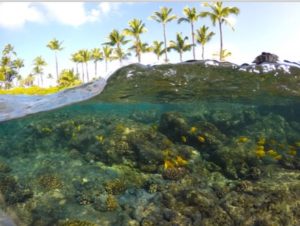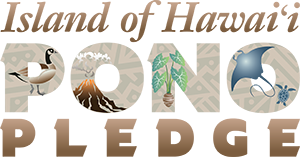He pilina wehena `ole ke aloha honua.
(One’s love for the planet is an inseverable relationship.)
The raw beauty of Hawai`i Island draws visitors from across the globe who come to enjoy the beaches, water sports, hikes, unique wildlife and landscapes, and so much more. But along with the rising visitor count comes an increasing need to protect and preserve what lures people here in the first place.
“As we saw our visitor numbers jump in early 2018, we had conversations with Hawai`i County and others about creating a tool that would educate visitors and residents about how to appreciate the island responsibly,” says Ross Birch, executive director of the Island of Hawai`i Visitors Bureau. Thus, the Pono Pledge was born.
The concept is simple: Give visitors the information they need to stay safe and keep from doing unintended harm to the environment and ecosystem that makes Hawai`i such a special place in the world.
ENDANGERED SPECIES CONCERNS
Of the 1,653 species listed as endangered or threatened in the United States, nearly a third (501 species) are found in Hawai`i. That’s nearly double the next highest state, California, which has 301. North Dakota has nine. The endangered species found mainly or only in Hawai`i includes the Green Sea Turtle (honu), the Hawaiian Hoary Bat (`ōpe`ape`a), the Hawaiian Hawk (`io), the Hawaiian Monk Seal (ilio holo i ka uaua), and the state bird, the Nēnē Goose. There are many more.

The Pono Pledge seeks to make visitors aware that even seemingly innocent acts, such as applying sunscreen when going to the beach, can have harmful consequences, as scientists believe that products containing oxybenzone and octinoxate — two common ingredients in sunscreen — contribute to bleaching in coral reefs. Studies have estimated that up to 14,000 tons of sunscreen end up in Hawai`i’s coral reefs every year. Consequently, state lawmakers passed a bill in 2018 that bans the sale and distribution of sunscreens containing those ingredients beginning in 2021.
Coral bleaching — which on Hawai`i Island disproportionately affects the Kohala Coast — not only deprives swimmers and snorkelers of a more colorful experience, but it lessen
s food supplies for fish and other undersea life, and thus the entire ecosystem is compromised. (It should also be noted that ocean warming is thought to be largely responsible for coral bleaching.)
“We promote the Pono Pledge at our booth on road trips, in our promotional messages and everywhere we can,” Birch says. “Group planners are using it as part of the pre-arrival package for their groups. Hotels have links to it on their websites. We’re spreading the message as far and wide as we can. We’re promoting the idea of ‘traveling pono.’ And that’s something that goes beyond our shores … people should be pono travelers everywhere they go.”
PONO TRAVEL
 Birch says that the Pono Pledge is being used as the basis for similar initiatives on other Hawaiian Islands, as well as by the Hawai`i Convention & Visitors Bureau, particularly as it pertains to safety tips and cultural sensitivity. Plus, it is a program that has been embraced by many Hawai`i Island residents, several of whom have signed on as ambassadors.
Birch says that the Pono Pledge is being used as the basis for similar initiatives on other Hawaiian Islands, as well as by the Hawai`i Convention & Visitors Bureau, particularly as it pertains to safety tips and cultural sensitivity. Plus, it is a program that has been embraced by many Hawai`i Island residents, several of whom have signed on as ambassadors.
“We hope when visitors come to visit our beautiful Hawai`i, that they come with an open mind and open heart,” says Pono Pledge ambassador and kahu (respected elder), Earl Regidor. “And be able to learn from the people that live here in hopes that they too will want to experience the beauty of the culture, the history, the people, and of course the ‘āina (land).” “What I think travel pono is about is being mindful of how you interact with the land,” says Soni Pomaski, restaurateur and another Pono Pledge ambassador. “Enjoy it, share it with people, but leave it as it is. Everything is alive and everything should be treated with reverence and respect, and I think that’s the best way to enjoy it.”


